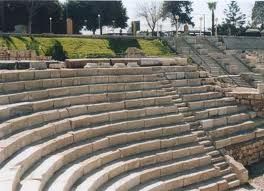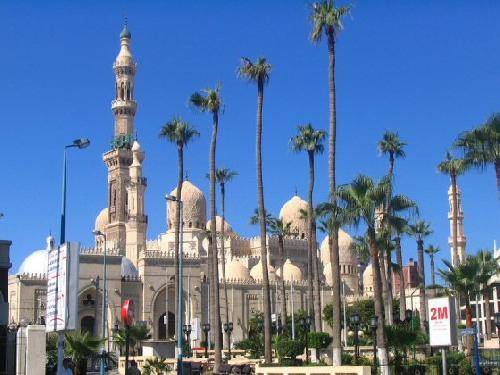
The Dream of Alexander the Great . According to Plutarch, Alexander the Great was haunted with a dream to found Alexandria in an island in the turbulent sea, in front of Egypt. Even before going to Egypt, he dreamt of a big, rich and prosperous city. In 332, Alexander defeated the Persians who were occupying Egypt at that time. In the wake of this victory, he was welcomed by the priest who declared him the Son of Amoun, and he was blessed in Luxor, Siwa and Memphis.
In the following year, Alexander founded the city that would take his name. The city was founded on the Nile Delta, on a village called Rakotis inhabited by a handful of fishermen, in front of an island called Pharos, which was connected to the mainland by a long dike. Choosing a perfect site, the city was protected from the revolts that could potentially arise from the Nile Valley. Additionally, the area was close enough to the course of the Nile as to insure a constant source of water to the city. The architect who made planed for the work was called Dinocratis of Rhodes. The construction of the dam formed two ports on both sides: the Great Harbor (to the east) and a trade port, still in use to our time.
The ports received bronze ingots from Spain; bars of tin from Britain; cotton from India; silk from China as well as other goods from all the countries of the Old World. The famous lighthouse was built at 280 BC on the island of Pharos by Sostral of Cnido. Dinocratis made the plan of the city in the form of a large square, with parallel and perpendicular streets of more than 30 m wide, always crossing at right angles. Neighborhoods were built and administratively divided into five districts, each of which were named after one of the first five letters of the Greek alphabet. When Alexander left Egypt to continue his war against the Persians, he appointed Cleomenes Naucratis manager of Alexandria. Witnessing a
great prosperity, the welfare of Alexandria accumulated. The Ptolemies built a marble palace with a large garden, fountains and statues. On the other side of the garden stands a museum, which comprises a large library. Around this building stood the Temple of Serapis, the new Greek-Egyptian god. At the city center lies the Assembly, squares, markets, churches, bathrooms, gymnasiums, stadiums and other public buildings. The inhabitants of this magnificent city were mostly Greeks. Also dwelt in the spot were a Jewish colony and neighborhood Egyptian fishermen. Soon, Alexandria became the center of the Greek culture in the Hellenistic Era.
- The Museum and the Library in Alexandria

Ptolemy II Filadelfo was the founder of the building erected near the Royal Palace, known from the beginning as 'The Museum', a name driven from the Muses (the G reek goddesses of the arts and sciences). Considered the oldest scientific establishment in the world, the Museum comprises different sections dedicated to knowledge. A big section was the Library, which became the most famous in the Old World. Within its compound, it also comprises a botanical garden, a zoological collection, an astronomical observatory and a number of rooms for scholars all hosted by the kings who were proud of their institution. In the Ptolemaic Period, Alexandria had 14,000 students of rhetoric and grammar, geography, philosophy, astron
reek goddesses of the arts and sciences). Considered the oldest scientific establishment in the world, the Museum comprises different sections dedicated to knowledge. A big section was the Library, which became the most famous in the Old World. Within its compound, it also comprises a botanical garden, a zoological collection, an astronomical observatory and a number of rooms for scholars all hosted by the kings who were proud of their institution. In the Ptolemaic Period, Alexandria had 14,000 students of rhetoric and grammar, geography, philosophy, astron
omy, anatomy, mathematics and of other sciences. A number of great people had both learnt and taught in the Museum, among whom are Archimedes, Euclidean, Hiparco, Aristarchus, Eratosthenes, Herophilus of Chalcedon, Apollonius of Pergamum, and Heron of Alexandria.
- The School of Alexandria
At the beginning, the name referred to the Jewish philosophy of Philo, who lived in Alexandria in the first century, and interpreted the Bible by applying the methods of Platon. But later, the name was applied to the school of philosophy of the Christian thinkers of the 2nd and 3rd centuries whose ideas had a powerful influence on the whole theology of the Early Church. One of its main representatives was Clement of Alexandria, the founder of the Alexandrian Church.
- Alexandria under The Roman Rule

During the Roman Period, Alexandria suffered various disasters and various wars that left behind a great deal of destruction. It was struck by the Bucolic War in 172-5 as well as the sabotage of Caracalla in 215, Valerian in 253, the troops of Zenobia (Queen of Palmyra) in 269, and Aurelian in 273. This latter destroyed completely the Bruchion and damaged both the Museum and the Library. One of the worst damages suffered by the city was the revolt of Lucius Domitius, in 297, which ended after Diocletian besieged the city for 8 months (victory commemorated by the so-called "Pillar of Pompey"). It is said that after the capitulation of the city, Diocletian ordered that the carnage would continue until the blood reached the knees of his horse. Besides the wars, the city suffered several earthquakes; the one in 365 was particularly devastating. According to some sources, the death toll reached 50,000 in Alexandria. It is documented that at least 20% of the city of the Ptolemies sank in the waters, including the Bruchion and the Library.
- Alexandria and Christianism
In 61, San Mark came to Alexandria to preach the new faith. Soon, he gained the support of many people who sought peace and freedom that the new religion calls for. Shortly after that San Mark was chased under the mandate of Emperor Nero in 62 and he was assassinated. Since then and until the time of Emperor Trajan (early 2nd century), Christians had had to hide their christianity for fear of persecution by the tyrant rulers.
- Alexandria and Islam
After 14 months of siege, Alexandria was conquered by Muslim troops at the end of 642. When the Muslim commander, Amr Ibn El As entered the city, he made an inventory of what Muslims found in the city: "4000 palaces, 4,000 baths, 12,000 merchants of oil, 12,000 gardeners, 40,000 Jews as well as 400 theaters and places of entertainment". Some historians say that the Arabs destroyed the library of Alexandria, but the truth is that the library did not exist at the time. Rather, it was a victim of civil wars and earthquakes.

- Modern Alexandria
Alexandria or the Mermaid of the Mediterranean is one of the most popular tourist attractions in Egypt. It is distinguished by its magnificent weather throughout the year but best time to visit Alexandria is in summer for enjoying safe and comfortable swimming. In Winter Alex is quite colder than Cairo and receives more rains and sea at that time is quite shelly which makes swimming difficult.
Alexandria can be easily reached through Burg El Arab Airport 25 km away from the city or El Nouzha Airport 7km from it. In addition, some tourists prefer traveling from Cairo to Egypt using train and this is also available since one can take the train from Misr Station in Ramsses till Sidi Gaber Station in Alex. After the reconstruction of the Bibliotheca Alexandrina the city became regarded as one of the cultural capital of Egypt. There are other restoration processes has been made for regaining the glory of the Ancient city such as widening the corniche stretching throughout the long beaches of white sand for allowing people jogging and enjoying the marvelous weather.
Of special interest in the tourist places in Alexandria is that it date back to different eras such as Greco-Roman Museum , Qayetbay Citadel , El Montazah Palace and Bibliotheca Alexandrina. On top of the most visited places in Alex is the lighthouse that is regarded as one of the Seven Wonders of the World. Tourists prefer interacting with Alexandrians for their kindness and friendly nature.
 The major part of those inhabitants are either working in the harbor or working as fishermen. Some of the inhabitants are employed in the factories since it is famous for paper, processed foods, chocolate, vegetables, cotton textiles, and oil. Shopping in Alexandria is not a difficult matter because there are numerous malls and shopping centers with high prices for the upper class members along side with other small shops with good prices.
The major part of those inhabitants are either working in the harbor or working as fishermen. Some of the inhabitants are employed in the factories since it is famous for paper, processed foods, chocolate, vegetables, cotton textiles, and oil. Shopping in Alexandria is not a difficult matter because there are numerous malls and shopping centers with high prices for the upper class members along side with other small shops with good prices.
